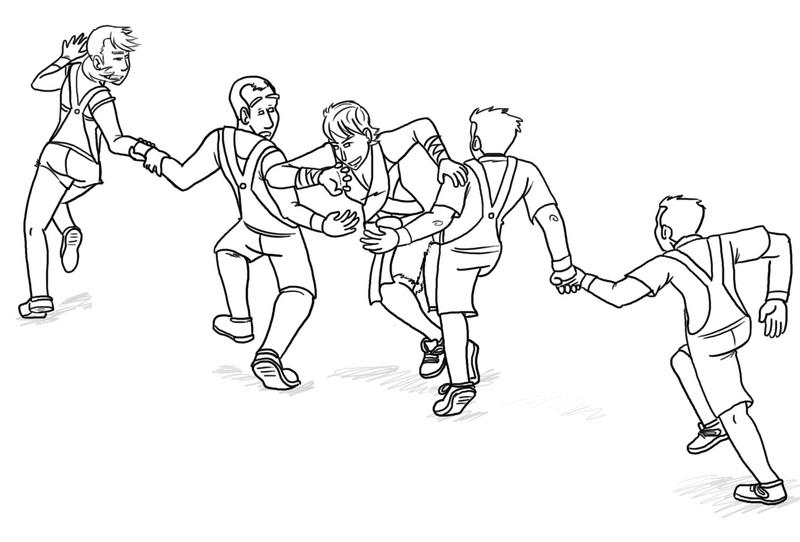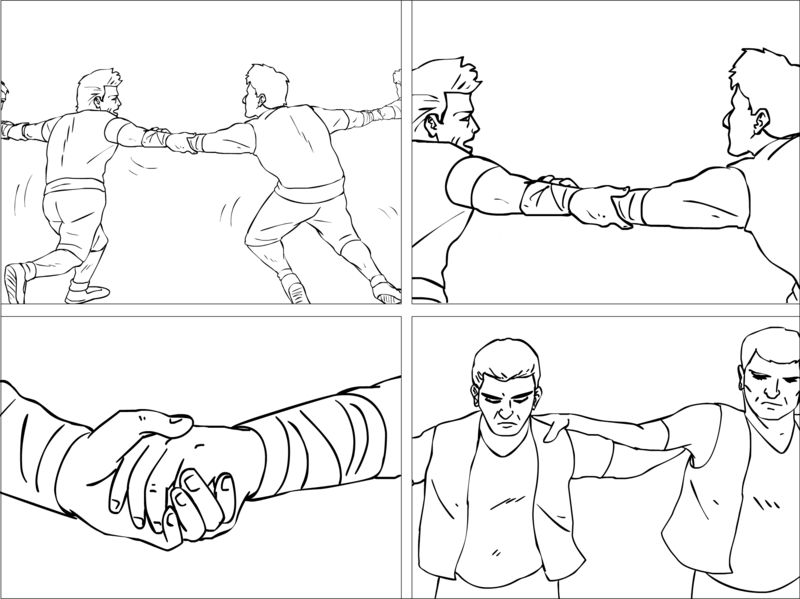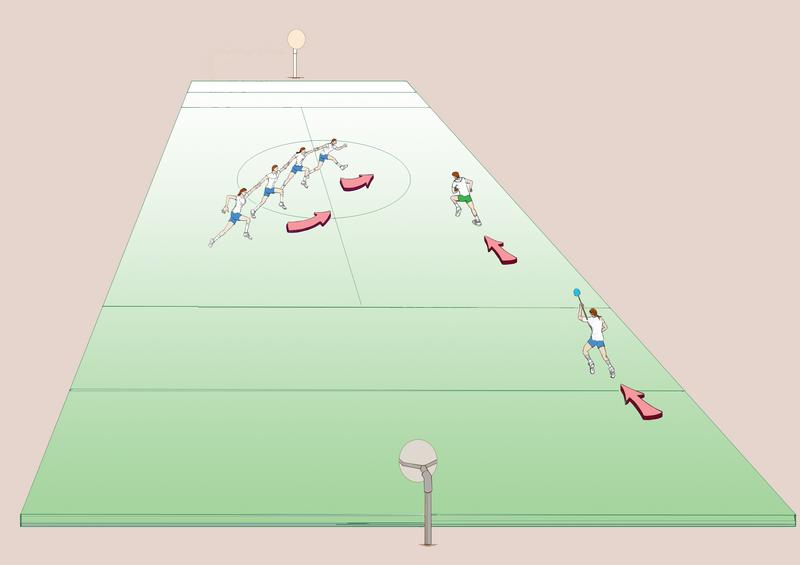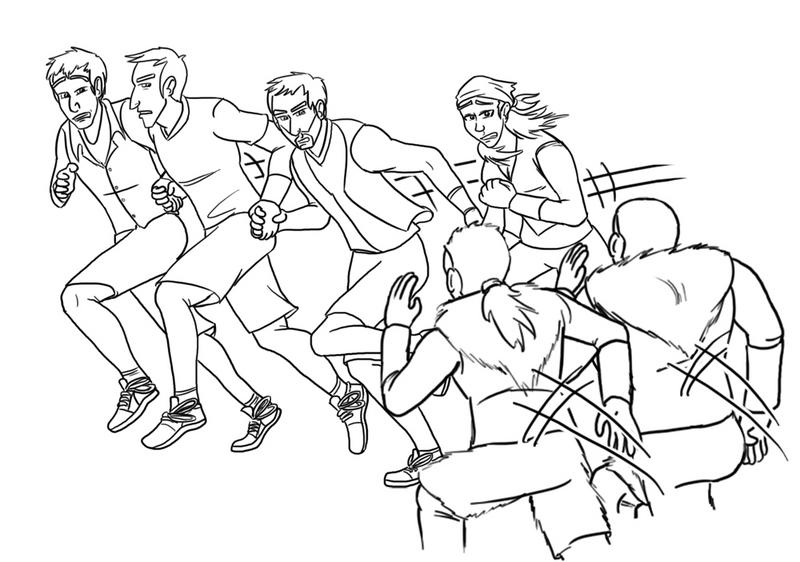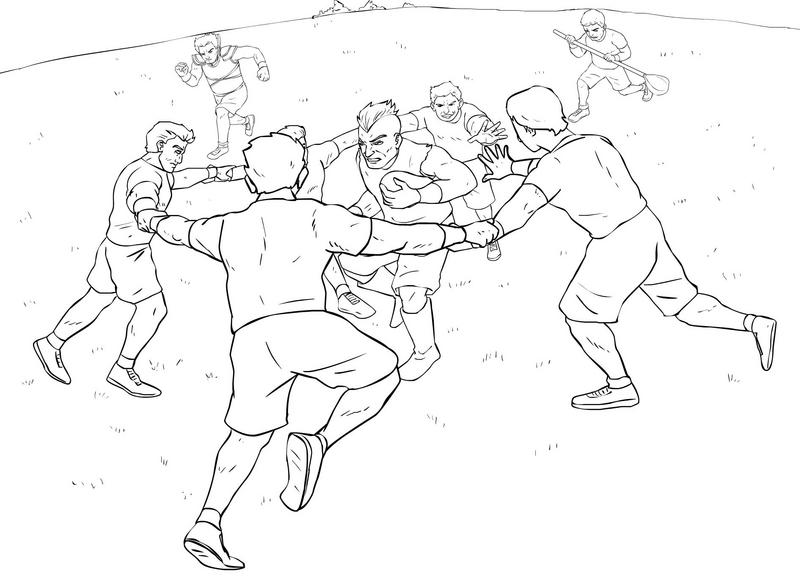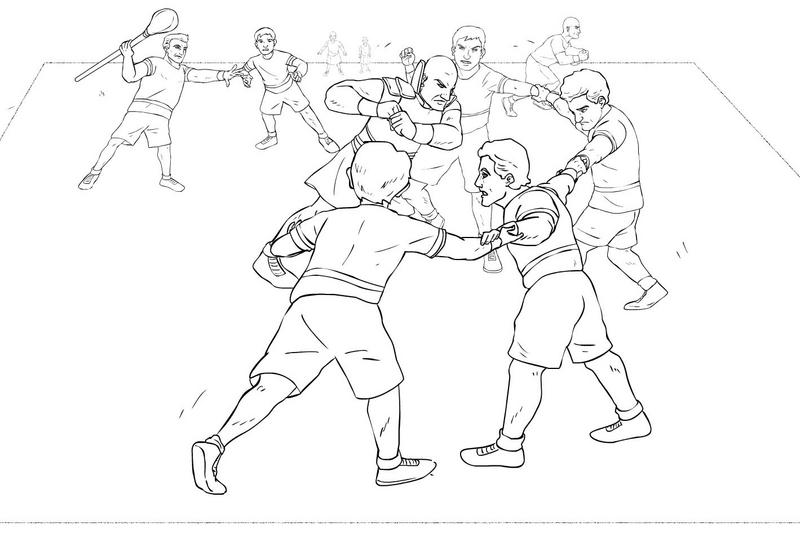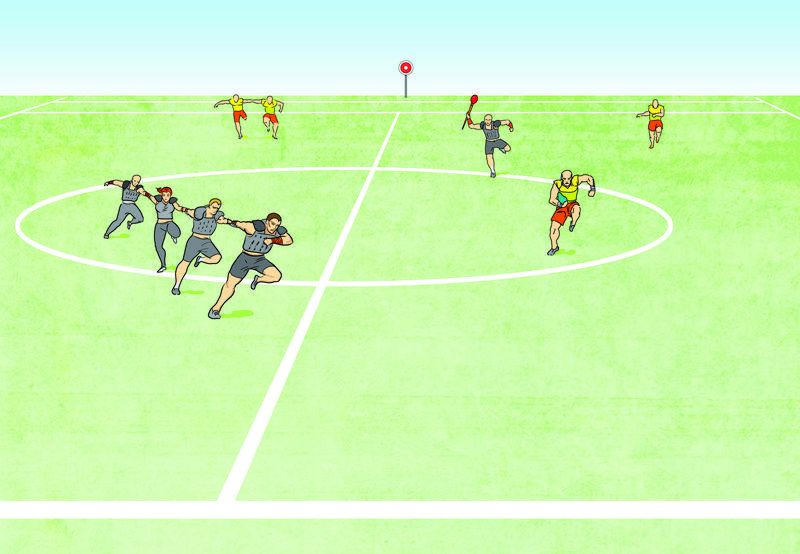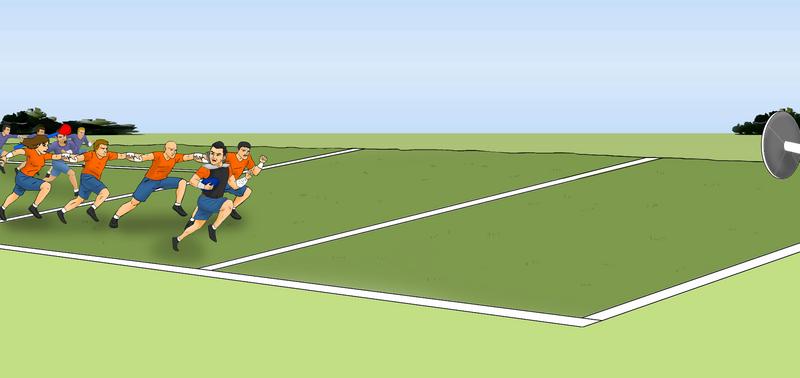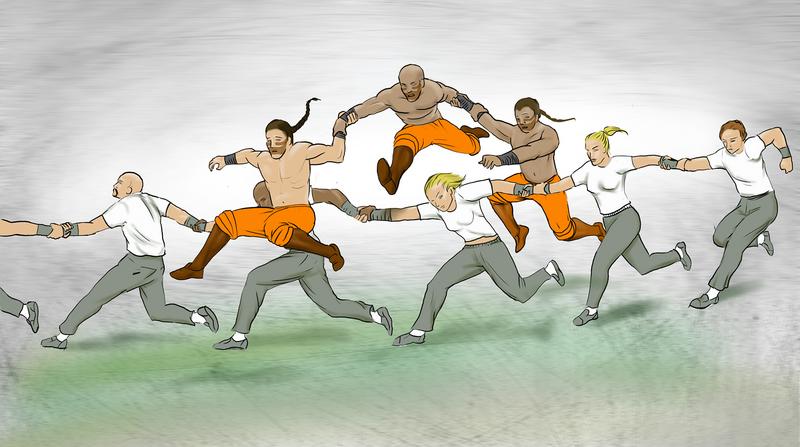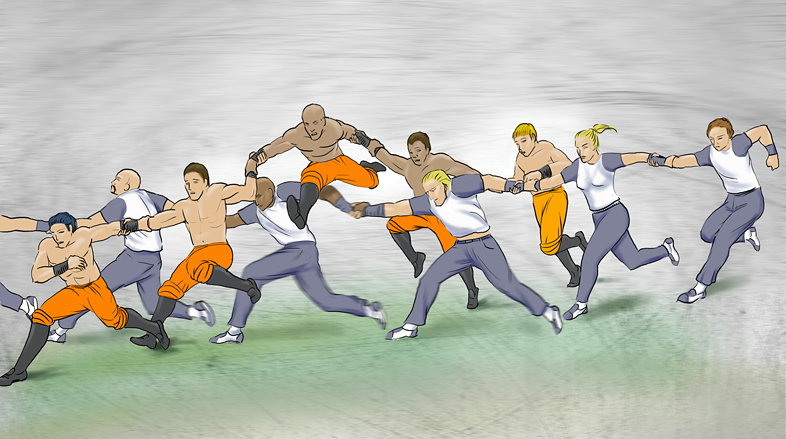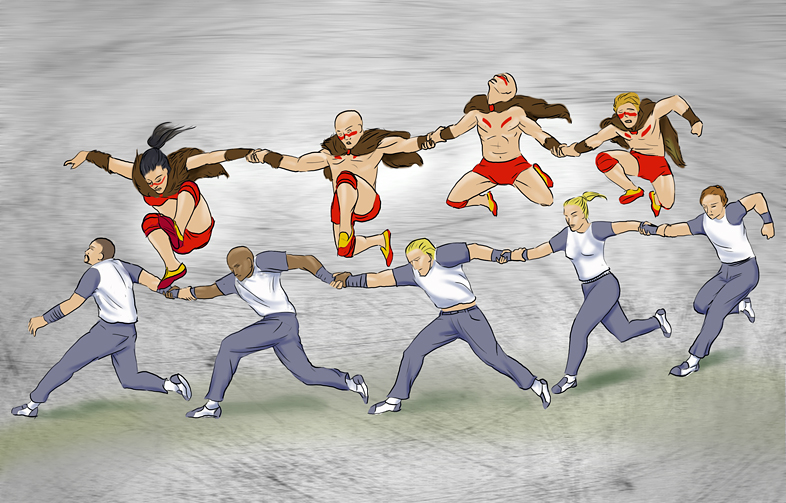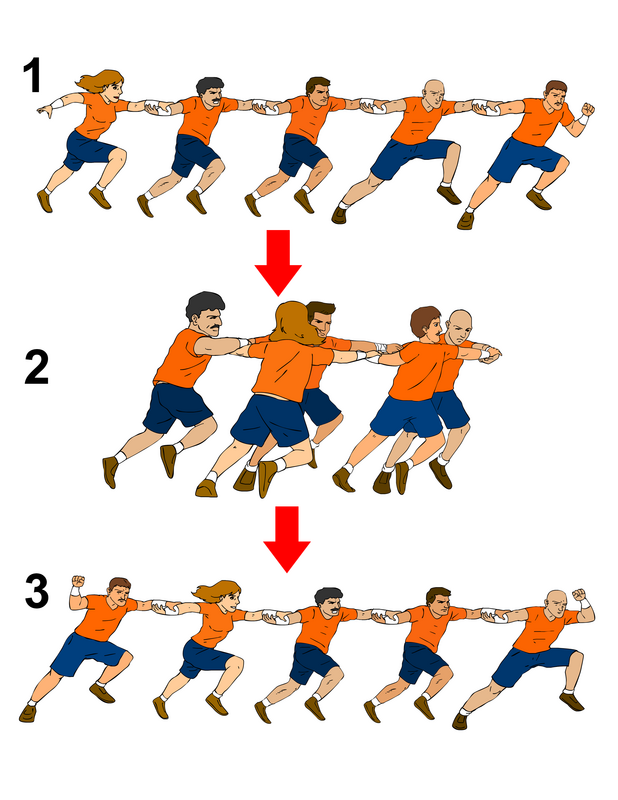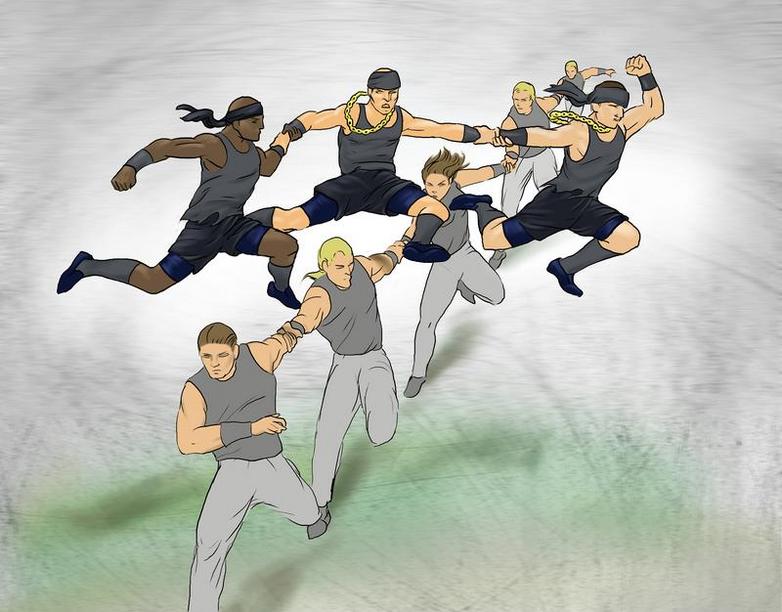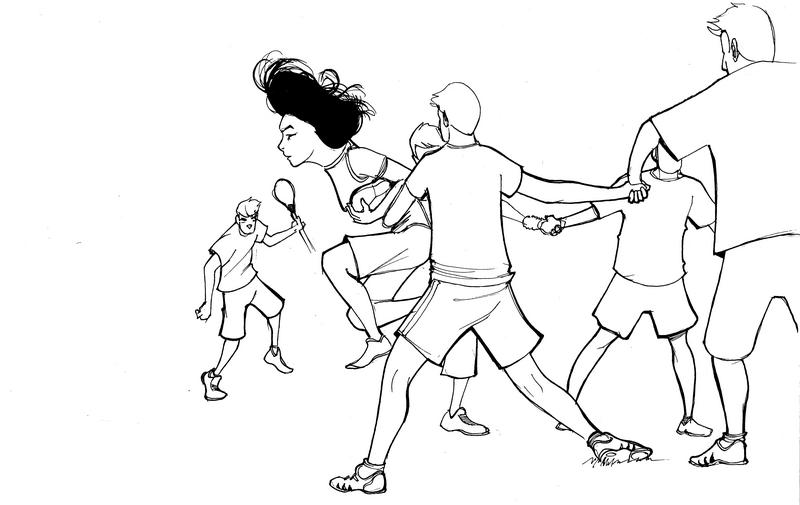Page Nine (9)
It’s A Stand-up Game:
With the exception of Flinging, the foot version of Polearmball is a stand-up game. Polearmball on foot is played in an upright position. There is no tackling or pushing people to make them fall. Players may not charge an opponent which results in physical contact of the torsos. Infractions against the torso or contact with someone’s torso are at the discretion of the referee. The Runner must make every effort to maneuver around any player in his/her path. The Runner and all players must avoid forces against their opponent's torsos.
The polearm may only be used to joust or spear an opponent. The polearm may not be used as an implement or weapon to batter, trip, hammer, pound, or assault an opponent. Every effort must be made to solely use the polearm in a forgiving manner with a forthright intent to score points but not to brutalize an opponent. A deliberate or careless strike to the head or groin or legs is a foul. Note: An airborne polearm is not necessarily a foul if it strikes the wrong part of someone's body. A deliberate forceful throw at close range is more apt to be an accurate blow compared to a long range throw. If an offensive player (polearmist) uses a short or medium range trajectory and it results in a careless strike then it will probably be called a foul. A long range throw which cannot be as accountable for accuracy as a close range throw, might not be called a foul if this type of throw strikes the wrong part of the Runner's body. The decision will be at the discretion of the referee.
Holding a player’s torso is not permitted. The referee at his discretion may call “holding” and this will result in either a technical or personal foul. The hands and arms must remain open and out. Players may push against open arms and hands to go around but may not forcefully push against the opponent's torso.
Both defensive and offensive players may form human chains in an attempt to Encapsulate opponents or to form Blockades. Both defensive and offensive players may be encapsulated. Encapsulated players not in possession of the ball must retire to the Midfield Circle. If the Runner is encapsulated then five (5) points are awarded and the round ends and the sides switch. An encapsulated Runner is worth five (5) points. An encapsulated player who is not the Runner but has possession of the ball is worth four (4) points and the sides switch.
Human Chains, Blockades, Blocking and Trapping:
30 to 40 percent of the game
A single player may encumber another player by stretching out his arms and standing or running in an opponent’s path. The opponent is responsible to not commit a foul. The opponent may not ram into a player's torso. No hitting, slapping, or brutality is allowed. The opponent who is encumbered by another player or line of players may run against their hands and/or arms. No holding of any sort is permitted unless holding results in a successful fling. An unsuccessful fling is a foul because it results in a holding violation.
Players on the same team may interlock their hands or arms with each other. The purpose is to form a blockade which will encumber other players in their pursuit to assist or impede the Runner. The defense will work so that their human chains assist the Runner and the offense will work so that their chains impede or encumber the Runner and encumber the Runner's teammates.
When more than one player joins hands or arms with a teammate to form an even wider obstacle which an opponent must navigate this act results in an obstacle on the playing field. In the role playing aspect of the game human obstacles simulate almost any imaginable obstacle that pursuing aggressors or chased prey in a real hunt would encounter in the wild. Obstacles or human chains represent boulders, trees, streams, brush, cliffs, etc.
The members of a blockade or human chain may not release their hands or arms once their arms or hands are joined together until the round ends. A player who is a part of a human chain may adjust his grip and may move from the hands to a more firm position on his teammate’s arm. Players may also slide from a firm arm grip to a hand hold or hand to wrist hold. A player must be careful when making an adjustment that the referee will not call a foul for breaking the chain. Sacrificing the integrity of the human chain will result in a foul and all members of the chain will be included in the foul and sent to the Midfield Circle.
A human chain may close into a circle and break the circle between any two of the players in the circle to reform a line. This lends a measure of versatility to rearrange the order of the players in the line.
Breaching a Blockade:
It is permitted to run or charge into a blockade or human chain with the purpose of breaking the chain. Physical contact against the arms and hands of the members in a human chain is permitted. Hitting the torso of a member of a chain is a personal foul and not permitted. If any two (2) or more members of a chain let go so that the human chain is breeched then the entire chain must retire to the Midfield Circle. No more than one (1) opponent may charge a human chain. If the charging player runs into the torso of a member of a chain which results in a successful breech it will not count for points and a personal foul will be called against the aggressor per member in the chain. After the foul is redeemed the chain is not reformed. A normal game re-start is played out.
You Are On Page Nine (9)
To Page Eleven (11)
To Page Twelve (12)
To Page Thirteen (13)
To Page Fourteen (14)
To Page Fifteen (15)
To Page Sixteen (16)
To Page Seventeen (17)
The Nature of a Sport that uses Human Chains
Two, three, or more players who intend to form a blockade whether they have the intent to encapsulate an opponent or stay in a straight line, may sprint next to each other without joining arms. At the right moment is when they suddenly simultaneously join arms and close the ranks into an interlocked line. However, they will probably not slow down. Whether they stay in a line or begin to form a semicircle or form a complete circle, they continue to sprint. Even as they encapsulate an opponent the line does not slow down. They sprint along pacing the opponent whom they are encapsulating. The chain is a moving and sprinting line which morphs into the forms they need to take in order to block, trap, or encapsulate an opponent. Some of the players in the line may be twisted as they run in order to keep up the speed without having to run backward. In a circle as the circle is sprinting, some players will be in better running positions than others. This is why some of the individual players who are running as the circle is forming may be twisted in order to stay in a more forward position as they run. Chains may also be formed by warriors who time their distances in such a way from different angles and different directions that they meet together at the same point on the field to form a line that keeps on running. Even more, another warrior may run and arrive a moment later after the line is formed and jump into the air as he/she latches onto an end player and they swing that airborne warrior around like a whip in a similar way as in the sport of Roller Derby in order to close into a circle and encapsulate an opponent instantaneously.
Interlocked lines are moving and sprinting entities that act as coordinated units. The word that best describes the necessary coordination is "synchronicity." As the chain of players sprint across the field of play they are like loose paper ribbons that undulate in the wind as they maneuver around stray warriors and other chains of players on the field.
A few words about the offense: (Players who have possession of the polearm).
If you are on the offensive side controlling the polearm then your team will not only be forming blockades to impede the Runner. The rest of the players who are not in blockades will also be sprinting to gain strategic positions on the field in order to catch the polearm when it is thrown to them. This is similar to Basketball when players are putting their arms up as they run so that the ball will be passed to them. The same holds for Polearmball. The offense will be passing the polearm around continuously trying to get a shot at the Runner. The Polearm will almost always be in the air passing from one player to the next. This means that no offensive player will be just standing around out of the action. On the contrary. Each player who is not in a line will be maneuvering to get in a position to have the polearm thrown to them so they can take a shot at the Runner. Or to pass the polearm to someone else who will be in a better position to attack the Runner.
The dynamics on the field change dramatically during a Doubling attempt. Now there are two running targets on the field and the second one keeps changing as the ball is passed from one player to the next. The strategies and dynamics of Polearmists, lines, and individual players all change.
The fact that the Runner can run to either end of the field to score a Delivery also makes for dramatic action on the field. First he/she may be heading one way and then moments later he/she is headed the other way.
Add the parkour and the kiais to the mix and what you get is a wild frenzied sport that is all action and a thrill every second.
Polearmball is a sport which takes team work to an unprecedented level. The forming of human chains and their singular purpose between many players means not only an intuitive discernment of the plays ensuing but also the development of coordination between players that must be learned and practiced until running in chains is second nature. In addition the chains must remain intuitive and attentive to the dynamic changes of the circumstances between the ever changing polearmists and the changing locations of the Runner on the field.
Webbing Or Bagging The Runner
A human chain or line is like a spider web with its arms stretched out and interlocked. As the Runner is followed and approached by the line and the Runner begins to be crowded it is possible for the line to make physical contact with the Runner and thereafter begin to envelope the Runner. During this process as the entire line continues to run with the Runner the line may either begin to trap the Runner like a spider's web or begin to bag the Runner as the Runner presses against the line. The Runner as he/she begins to be impeded by the line will begin to be forced to slow down. Webbing or bagging the Runner describes this dynamic moving process of capturing or webbing or bagging the Runner. As the Runner is webbed or bagged then a nearby Polearmist may then have an opportunity to come in and attack the Runner for a Kill.
If a player who charges against a blockade is not successful then a foul is called against the aggressor and the aggressor must retire to the Midfield Circle. If an attempt to breech a blockade fails then the player who failed is considered as overcome by the enemy in the role playing aspect of the game. Multiple players may not charge a human chain.
A player has three choices when facing a blockade or encapsulation: One; go over. Two; escape or avert on foot by running. Three; charge the line in order to run into the chain so as to break it.
If a Runner charges a blockade in order to break it and does not breech it then it shall be considered a Kill against the Runner and the sides switch. If a teammate of the Runner has the ball and attempts to break a blockade but fails then it is considered a Kill and sides switch.
The points awarded shall be as follows:
Breaking a line successful- One (1) point per player in line.
Runner fails- Three(3) points.
Runner's teammate with ball fails- Two (2) points.
Runner's teammate without ball fails- One (1) point.
Note: No polearmist may attack a line. No one in possession of the polearm may charge a line to break it. However, a polearmist may go over a line using acrobatics or parkour maneuvers.
In this scene a player who is not the Runner has successfully broken through the line. The line was on the run when an opponent decided to rush in. Each member of the line must retire to the Midfield Circle for the remainder of the round. The opposing team is awarded one point for every player in the line. In this scene the attacking player's team is awarded four (4) points for the successful breach.
In the image above please note the different ways in which the members of a human chain may hold-on to each other. Some methods are more secure than others. Some methods offer more mobility to run or maneuver on the playing field. Members in a chain may switch methods from one to another by sliding from one grip to another as long as the chain does not break apart during the transition. The integrity of the chain must not be compromised. Arm wraps will be expedient to improve friction for a better grip.
A blockade will be useful to encumber the running path of the Runner and improve the chances that the polearmist will be able to spear or joust the Runner with the polearm. A blockade can be used to corner the Runner and improve the chance that a polearmist will have a better shot to throw the polearm at the Runner or joust the Runner. Should a Runner become encapsulated, the offensive team scores five (5) points and the sides reverse. The Runner is not required to possess the polearmball for this to occur.
A player may attempt to escape an ensuing trap or encapsulation by running out of the open ends. So long as the player who is being encapsulated does not force himself against an opponent's torso, he/she may escape by force against hands and arms at the open end of the closing blockade. Hands and arms may not be used to punch, hit, slap, hold, or hammer an opponent. No kicking or kneeing is permitted. Once a human chain has successfully closed around an opponent causing him/her to be encapsulated, the trapped player may not force him/herself out.
A player who is adept may jump over, catapult over, vault over, cartwheel over, forward roll or kip over, flip over, jump to stand on the arms or shoulders, or leap over, or use the polearm to pole-vault over an ensuing encapsulation or a over a blockade as long as no foul or injury occurs in the process. The acrobatic player must land on his feet. A fall or touching the ground with other than the feet will constitute a foul and the acrobatic player who does not have the ball will be retired and required to play out the remainder of the round in the Midfield Circle. Upon falling a Runner or teammate with the ball will cause sides to switch and will lose possession of the ball. The human chain must close and join arms or hands around the opponent while the opponent’s feet are on the ground in order to get credit for an encapsulation. If the acrobatic opponent is already airborne when the chain finishes closing the circle then the encapsulation is not valid. The victim’s feet must have contact with the ground and the chain must be closed at that moment to get credit for an encapsulation. If successful the referee will shout, “Kill.”
Using an opponent’s head to perform a vault or catapult over a blockade is not permitted. Catapulting over a blockade will need to be accomplished using free flight or by pushing off the opponent's arms or shoulders but not the head. A Runner may charge a blockade and ricochet over it by using one hand to push off of an opponent's shoulder. The intent of the game is to use skilled acrobatic or parkour maneuvers to overcome and bypass human chains.
Another option open to players which have formed a chain of two (2) or more players that wish to encumber a single opponent or encumber an opponent's blockade is to grab an open end of a human chain by grabbing an opponent’s hand or arm. A chain may interlock to the arm or hand of a single opponent or an open end of a blockade. For as long as the blockade is steadfast and an opponent or other chain is attatched to it then the line may hold and steer the other line or opponent according to fortitude. Only one arm may be used. The other free hand or arm may not be used. Using two (2) hands to hold someone’s arm is considered holding and shall be called a foul. In effect, the maneuver to hold an opponent or opponent's chain by one arm or one hand becomes a tug of war. Players may not hit, slap, hammer, kick, or strike each other at any time. They may however jerk and pull away from an opponent that becomes attached. Pulling an arm of an opponent behind their back or any brutal action may be called a foul by the referee.
A single player may not grab the open end of an opponent's human chain. Only chains may grab an opponent. A single player who grabs an opponent must result in a successful fling or it will be called a personal foul. A chain may release an opponent at will without penalty.
In the event that a single player grabs the end of an opponent's chain then he/she must fling the entire chain to the ground and it shall not be called in a foul. The result will be a credit to the single player garnering one (1) point per every opponent in the chain.
In this scene please notice that the Polearmist is in pursuit of the Runner. The Polearmist's teammates have conjoined to form a human chain and will attempt to outrun the Runner so as to get in front of the Runner and block the Runner's path to the Delivery Line. The Polearmist may then approach from behind and attempt to either joust the Runner or Spear the Runner while the Runner is blocked by the blockade of the Polearmist's conjoined teammates.
In this scene please note that two opponents are charging the conjoined players who have formed a human chain. This is not permitted and is an infraction against the rules. Two players at the same time may not attempt to break a line.
Players forming a blockade may attempt to trap or encapsulate an opponent. Three (3) or more players may encapsulate an opponent. Two (2) players may not encapsulate an opponent. If three (3) or more players who form a blockade are able to join their hands or arms around an opponent then that opponent is taken out of play and sent to the Midfield Circle (if they are not the runner or don’t have the ball). An encapsulated opponent who does not have the ball is worth three (3) points. Both the offense and the defense may encapsulate opponents and score points in the same round.
This scene shows an encapsulation ensuing of a player in possession of the ball who is not the Runner. The Runner in this scene is wearing a protective vest. The Runner has passed the ball to his teammates in an attempt to Double the value of a Delivery.
In this scene the Runner has been impeded by a Blockade whereas the Polearmist may now improve his/her chances of either spearing or jousting the Runner by running in from behind.
In this scene above the Runner is being pursued by the opposing team's Polearmist. Some of the other opposing team members have formed a chain which is furiously racing to get in front of the Runner in order to get in the Runner's way. Once the Runner is encumbered by the chain then the Polearmist may then come from behind and attempt to either spear or joust the Runner who is trapped by the chain.
In this scene the Runner's teammates which have formed a chain are shielding and guiding the Runner toward the Delivery Line. In the role playing aspect of the game, chains are obstacles which represent streams, rivers, trees, hills, boulders, etc. Obstacles can serve to impede and trap prey as well as protect and shield what is being pursued. Teammates will seek to shield and protect the Runner while opponents will seek to trap and ambush the Runner.
Flossing and Combing
Chains may at times if so skilled be compelled to fly over another chain. If we call one conjoined group of players a line and another conjoined group of players a chain then we can say that a chain may choose to fly over a line. There are two fundamental methods which may be employed. Flossing is when a chain flies over a line in single file perpendicular to the line. Combing is when a chain flies over a line broadside.
In the illustration above a three man chain Flosses a six man line.
In the illustration above a five man chain Flosses a six man line.
In the illustration above a four man chain Combs a five man line.
Note the position of the female Polearmball warrior before and after the circle has been made. A human chain may close into a circle and break the circle between any two of the players in the circle to reform a line. This lends a measure of versatility to rearrange the order of the players in the line.
Three man chain jumps over a line in a level and unified manner.
They leave the ground together and land at the same time on the other side.
In this scene the Runner failed to break the chain. However, a Polearmist stands ready to spear the Runner in the event the Runner breaks through. A failed attempt by the Runner to break a chain results in a Kill against the Runner. Sides then switch for a new round.
